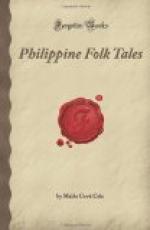[80] Cabildo of Domayco, the envied owner of this jar, has refused great sums offered for its purchase, and though men from other tribes come bringing ten carabao at one time, they cannot tempt him to sell.
[81] These beautiful agate beads are still worn by the Tinguian women, who prize them very highly. They are rarely sold and each is worth more than a carabao.
[82] The Alan are supposed to be deformed spirits who live in the forests. They are as large as people, but have wings and can fly. Their toes are at the back of their feet, and their fingers point backward from their wrists.
[83] The name by which spirits call human beings.
[84] This treatment of the Alan is typical of that accorded to the less powerful of the spirits by the Tinguian today. At the ceremonies they often make fun of them and cheat them in the sacrifices.
[85] Known to the Tinguian as Banog. This bird occupies much the same place with the Tinguian as does the garuda in East Indian folk-lore.
[86] This tale gives to the Tinguian his idea of the future world. Sogsogot is supposed to have lived only a short time ago, and his experiences are well known to all the people.
[87] See note 1, p. 15. Practically this same tale is told by the neighboring Ilocano, from whom it may have been borrowed; but here the Tinguian custom of paying a marriage price is introduced.
[88] This type of story is also found farther to the south, where the cleverness of the small animal causes him to triumph over the strong.
[89] The Tinguian house contains neither tables nor chairs. The people usually squat on the floor, sitting on their heels; if anything is used as a seat it is a bit of cocoanut shell or a small block of wood.
[90] Here we have a proverbial tale, one in which the Tinguian expresses the idea, “Haste makes waste.”
[91] Another version of this tale is found in British North Borneo in the story of the plandok and the crab, while to European children it is known as the race between the turtle and the hare.
[92] The story shows the influence of the Christianized natives, among whom cock-fighting is a very popular sport. It is found only among those Tinguian who come into contact with this class.
[93] Lumawig is the greatest of all spirits and now lives in the sky, though for a time his home was in the Igorot village of Bontoc, He married a Bontoc girl, and the stones of their house are still to be seen in the village. It was Lumawig who created the Igorot, and ever since he has taken a great interest in them, teaching them how to overcome the forces of nature, how to plant, to reap and, in fact, everything that they know. Once each month a ceremony is held in his honor in a sacred grove, whose trees are believed to have sprung from the graves of his children. Here prayers are offered for health, good crops, and success in battle. A close resemblance exists between Lumawig of the Igorot and Kaboniyan of the Tinguian, the former being sometimes called Kambun’yan.




